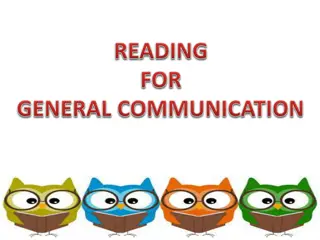Enhancing Public Scripture Reading for Better Engagement and Understanding
Improve the delivery of Scripture reading by ensuring relevance, clear introduction of passages, timing, and providing necessary context to enhance audience engagement and comprehension. These practices help in creating a more impactful and meaningful experience for listeners.
Download Presentation

Please find below an Image/Link to download the presentation.
The content on the website is provided AS IS for your information and personal use only. It may not be sold, licensed, or shared on other websites without obtaining consent from the author.If you encounter any issues during the download, it is possible that the publisher has removed the file from their server.
You are allowed to download the files provided on this website for personal or commercial use, subject to the condition that they are used lawfully. All files are the property of their respective owners.
The content on the website is provided AS IS for your information and personal use only. It may not be sold, licensed, or shared on other websites without obtaining consent from the author.
E N D
Presentation Transcript
Public Scripture Reading How to read God's Word aloud so people will really hear it! Dr. Rick Griffith Jordan Evangelical Theological Seminary BibleStudyDownloads.org
Mormons are reading The Book of Mormon more and the Bible less Percentage of LDS Church Usage of Books Considered Scripture, 1942-2013 (5-yr moving average) New Testament Book of Mormon Doctrine & Covenants Old Testament Pearl of Great Price Adapted from http://zelophehadsdaughters.com/ at 10 July 2014
9 The most important part of your sermon is the only thing that the audience hears as the actual Word of God!
9 So how can we read Scripture properly? Let's look at some problems and solutions
9 A. Too often the Scripture reading has nothing to do with the message of the morning. So make sure they relate!
9 B. We introduce the reference poorly so people have to ask one another where we are. So in the introduction always announce your text three times for those who did not catch it initially.
9 C. We begin reading before people have a chance to find the passage. So wait until you hear the pages stop turning before reading the text.
9 How will you know when they found the text on their smartphone?
9 How will you know when they found the text on their smartphone? Ask them to look up at you!
9 D. We don't give needed background information to understand the text (e.g., no context to start reading at Acts 14:21). So provide the needed context even before announcing your text.
First Missionary Journey of Paul & Barnabas (Acts 13 14)
9 E. Difficult words are sometimes mispronounced due to lack of preparation. So use The Book of Life guide at the back of the notes to pronounce names correctly (pp. 226-244)
9 F. We emphasize the wrong words. (Accent "gave," not "for," in Gal. 2:20). I have been crucified with Christ and I no longer live, but Christ lives in me. The life I now live in the body, I live by faith in the Son of God, who loved me and gave himself for me (Gal. 2:20 NIV).
9 F. We emphasize the wrong words. (Accent "me," not "before," in Exod. 20:3). You shall have no other gods before me (Exod. 20:3 NIV).
9 F. We emphasize the wrong words. So practice which words to emphasize and read the text aloud so many times that you almost have it memorized.
9 G. The passage is often read with a flat tone of voice. So vary your speed of speaking and volume. Read to children they're merciless!
9 H. It's hard to teach people to read well who have a "I already know how to read" attitude. So select 5 people at church who are good readers and give them this mini-seminar.
9 I. every reading with the trite clich , "May God add His blessing to the reading of His Word." We feel we always have to end If we read the Bible well, it will already be a blessing without us having to bless it.
9 Scripture Readings A. Narrative: Triumphal Entry (Mark 11:1-11) B. Prophecy: Heaven's Throne (Revelation 4:1-11) C. Lament: Petitioning Help (Psalm 70)
Get this presentation for free! Preaching (Homiletics) link at BibleStudyDownloads.org























